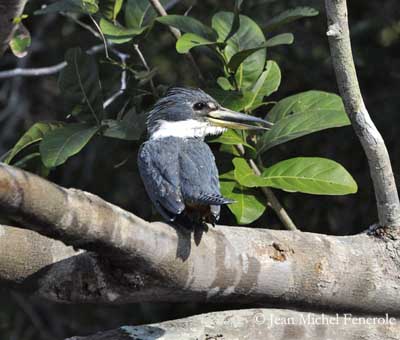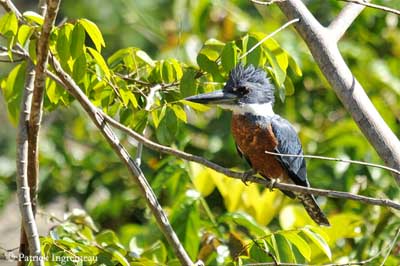
PROTECTION / THREATS / STATUS:
The Ringed Kingfisher is widespread in its range. The species is not threatened at this moment.
Fr: Martin-pêcheur à ventre roux
All : Rotbrustfischer
Esp : Martín Gigante Neotropical
Ital: Martin pescatore dal collare
Nd: Amerikaanse Reuzenijsvogel
Sd: Ringkungsfiskare
Port: Martim-pescador-grande
Photographers:
Patrick Ingremeau
TAMANDUA
Jean Michel Fenerole
Photos d’Oiseaux
Eduardo Andrés Jordan
MIS AVES – AVES DE ARGENTINA
Photos de Philippe et Aline Wolfer
OISEAUX D’ARGENTINE
Text by Nicole Bouglouan
Sources:
HANDBOOK OF THE BIRDS OF THE WORLD Vol 6 by Josep del Hoyo-Andrew Elliott-Jordi Sargatal - Lynx Edicions, 2001 - ISBN: 848733430X
A GUIDE TO THE BIRDS OF MEXICO AND NORTHERN CENTRAL AMERICA by Steve N. G. Howell, Sophie Webb - Oxford University Press - ISBN: 0198540124
A GUIDE TO THE BIRDS OF COLOMBIA by Steven L. Hilty and William L. Brown - Princeton University Press – ISBN 069108372X
The Birds of North America online
What Bird-The ultimate Bird Guide (Mitchell Waite)
Wikipedia (Wikipedia, The Free Encyclopedia)
Ringed Kingfisher
Megaceryle torquata
Coraciforme Order – Alcedinidae Family
BIOMETRICS:
Length: 38-40 cm
Weight: 254-330 g
DESCRIPTION:
This large kingfisher is found in South America. Its bushy crest and the huge bill make this bird very conspicuous.

Adult male has bluish-grey upperparts, including head, mantle, back and uppertail coverts, and also breast sides.
On the wings, primaries are black, whereas secondaries and wing-coverts are blue-grey. Inner webs are spotted-white.
The tail is black with blue-grey edges, and there are five pairs of white spots on rectrices.
On the underparts, breast and belly are rufous. Vent and undertail coverts are white barred grey. Underwing coverts are white.
The head is bluish-grey, with conspicuous bushy crest. We can see a white frontal spot and a broad white collar.
The large bill is blackish-grey with paler base and pale yellow base of lower mandible. Eyes are dark brown. Legs and feet are grey.
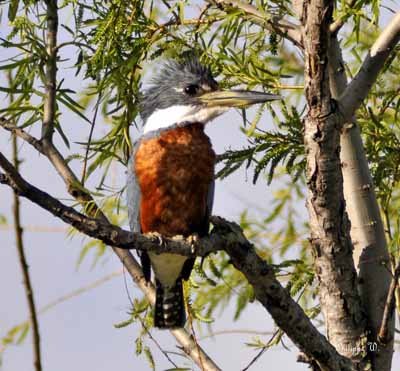
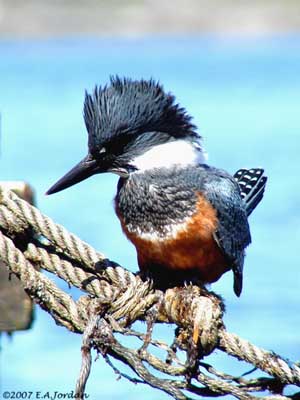
The female is almost similar, but she has blue-grey band on the upper breast, and a narrow white band which separates the rufous belly from the pectoral band.
Underwing coverts and undertail coverts are rufous.
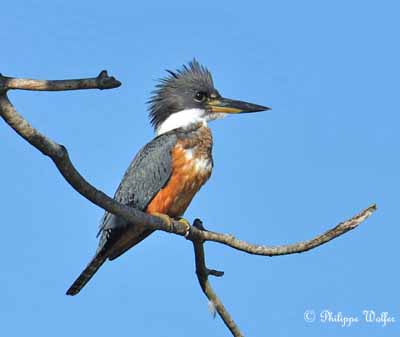
The juvenile resembles female but it has streaked upperparts. Underparts are paler with rufous tinge on the grey breast and underwing coverts are partially white.
We can find three subspecies:
M.t. torquata
M.t. stictipennis has white spots on secondaries.
M.t. stellata is similar to the previous, with undertail coverts more heavily barred grey.
VOICE: SOUNDS BY XENO-CANTO
The Ringed Kingfisher utters loud, chattering rattle as alarm call “klek-klek-klek-klek”. When excited, it produces loud, buzzy and screechy chatters.
The single, loud “klek” is used as contact call, but the same call is also given in flight.
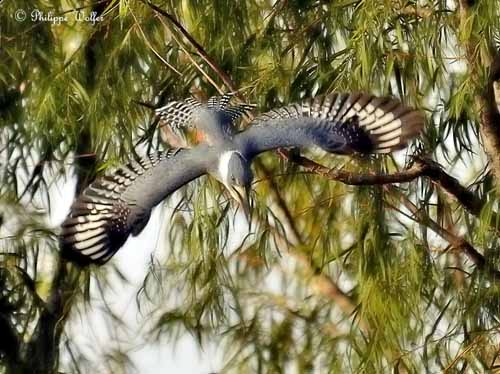
HABITAT:
The Ringed Kingfisher frequents large, slow rivers and varied types of waters such as lakes, marshes, estuaries, coastal lagoons, fiords (in Chile), ricefields, canals, mangroves and open beaches.
This bird is often found in heavily wooded areas, but it forages on reefs up to one kilometre offshore. However, it is most common in open areas such as open shorelines and pools near larger waterbodies.
Usually uncommon above 500 metres of elevation, it occurs from sea-level to 1500 metres in Guatemala.
RANGE:
The Ringed Kingfisher occurs from extreme south Texas in the US, in Central America and South America.
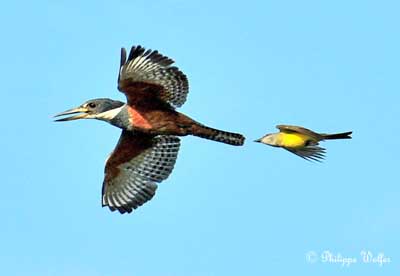
BEHAVIOUR:
The Ringed Kingfisher feeds primarily on fish of 18-20 centimetres in length. But it also takes reptiles, amphibians, crustaceans and insects. As other kingfishers, it hunts from a perch above the water, and when the prey is located, it dives steeply for catching it, and returns immediately to the perch. Then, it beats it vigorously against a hard surface before to swallow it head first.
When waiting for prey, the Ringed Kingfisher sometimes raises the crest and cocks the tail.
It also hunts by hovering at about 10-15 metres above the water, before to dive down.
It may occasionally take small mammals and berries.
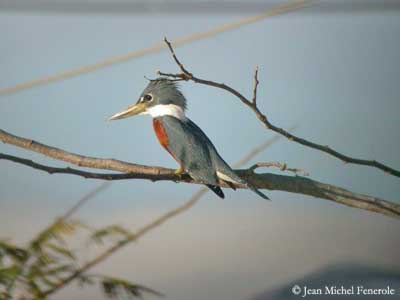
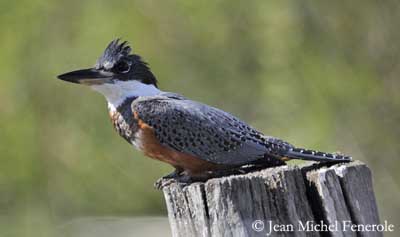
The territory is established close to the water, along shoreline of lakes and streams, and both sexes strongly defend the area all year round, by uttering loud calls and chasing away all intruders.
The Ringed Kingfisher is mainly sedentary, only performing local movements between the feeding areas.
Between November and March, the breeding visitors are in Southern part (Tierra del Fuego). The post-breeding migrations reach Valparaiso, NE Argentina and Buenos Aires, and some records mention the species in Trinidad in March-June.
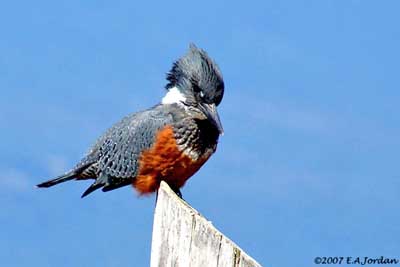
FLIGHT:
The Ringed Kingfisher has strong flight. It often flies high, with sweeping floppy wing-beats. It also hovers above the water when fishing.
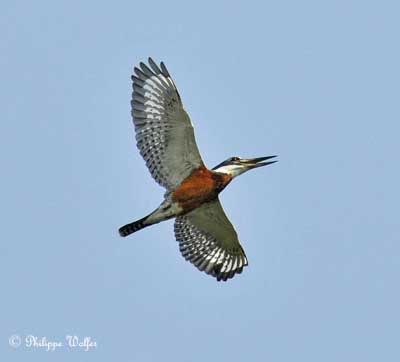
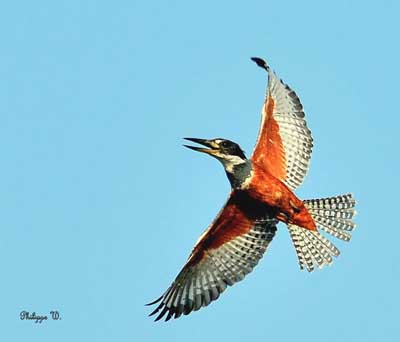
REPRODUCTION:
Breeding season varies according to the range.
The Ringed Kingfisher is usually solitary nester, but some observations mention small colonies of 4-5 nests, and one of 150 nests.
The nest-site is often situated in riverbank, or bank of lagoon or lake, but some site such as erosion gulley far from water can be used too.
The tunnel excavated by both adults is about 10 centimetres in diameter and often 2-3 metres long. At the end there is the nest-chamber, larger in size than the tunnel.
Female lays 3-6 white eggs and both parents incubate during three weeks. They feed the young which are almost feathered at 24 days, and leave the nest 33-38 days after hatching, flying strongly.
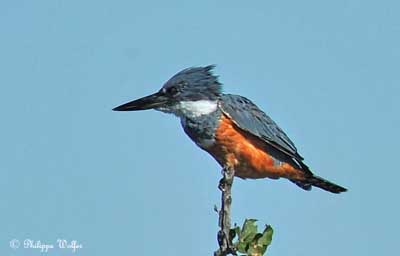
DIET:
The Ringed Kingfisher feeds mainly on fish of 18-20 centimetres, but usually 8-11 centimetres, of Characidae and Cichlidae species.
It also takes amphibians such as frogs and salamanders, reptiles, crabs and insects, and occasionally small mammals and berries.
It hunts from a perch or by hovering above the water.
